When you search for something on a search engine like Google, the results that appear are a list of websites. The position of a website in these search results is its search engine ranking. This position can vary depending on the keywords used in the search. For example, a website may rank high for one keyword but lower for another.
Tracking the keyword rankings of a website is important to understand its visibility and performance in search results. By monitoring these rankings, you can analyze the effectiveness of your SEO efforts and make informed decisions to improve your website’s visibility.
In this article, we will explore how to determine the position of a website in a search engine. We will discuss the importance of tracking keyword rankings, how to use rank tracking tools, and the steps involved in analyzing the results.
- What is a website position?
- Why track website positions on Google?
- Why monitor keyword rankings of a site or online shop?
- How to determine the position of a website in a search engine
- How much does it cost to assess a website’s position?
- Factors affecting a site’s position in a ranking list
- How to improve website positioning
What is a website position?
A website’s position is the place in the list of results that search engines such as Google, Yahoo, Bing, etc. give when a user enters a certain word or phrase. The same site may occupy different positions for different keywords. For example, a site that sells children’s goods may come in third place for the query “buy shoes for a boy in New York,” but fifteenth for the search phrase “inexpensive children’s shoes.”
This means that for the first query, the content on the page is optimized (i.e. contains useful information about the product, properties, selection, etc.), and for the second, the texts need to be adjusted and made more useful for the target groups.
Why track website positions on Google?
Users search for desired products or services using a wide variety of queries. Searches are based on combinations of words that include the name or characteristics of the products, and the region in which they live. A search query often includes commercial keywords list such as “buy,” “order,” “price,” and so on. In order to ensure that the search robot takes your page into account when entering a search query with the product to be promoted, you need to create content that is most relevant to the key phrase. That is, texts (product descriptions, useful thematic articles, business news) should include popular queries, which the target audience uses to look for the right product.
Why monitor keyword rankings of a site or online shop?
Understanding the ranking position is important, because:
- You need to determine the real positions of your site for high- and medium-frequency (HF, MF) key queries compared to your main competitors in the industry.
- You will be able to conduct keyword research, correct texts and improve search engine rankings. This can be done after analyzing the content of resources that are in the top 5 of search results.
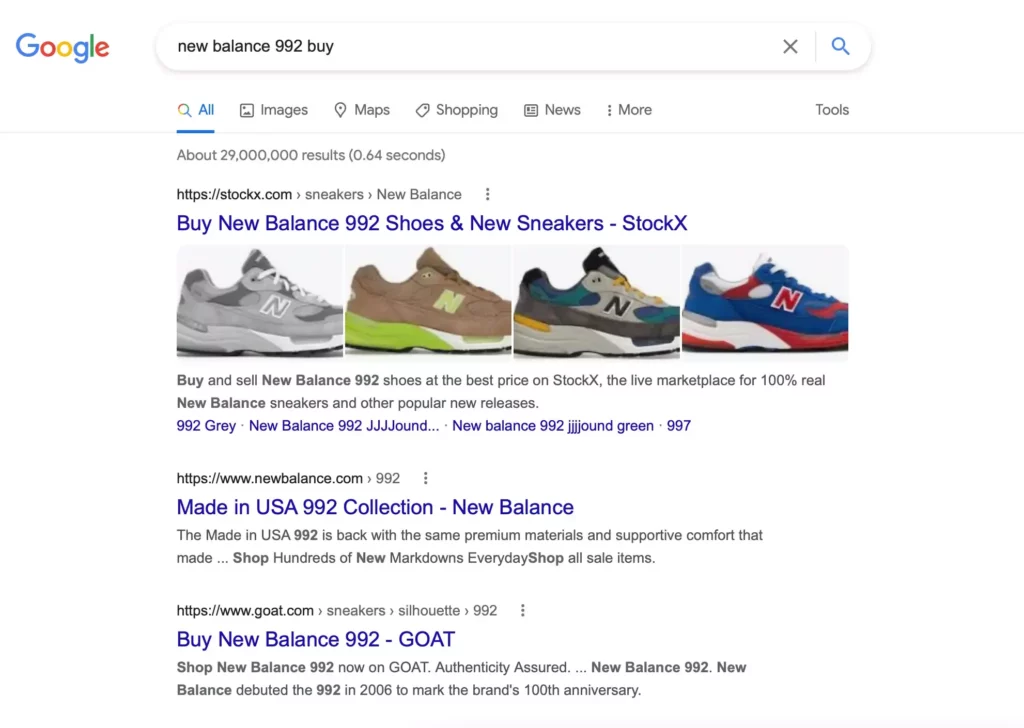
Understanding which results page a resource is on for the main keywords allows you to optimize texts and your on-page SEO and increase targeted traffic (visits). By monitoring website page positions, it is possible to improve content and keyword strategy and increase organic traffic and conversion rates without additional investment in online advertising.
This is very important for effectively promoting a commercial website, whose main goals are:
- high stable sales;
- increased brand awareness;
- access to new markets;
- profit generation and business development.

How to determine the position of a website in a search engine
Special services like rank tracking tools are used to monitor positions of web resources in search engines such as Google, Yahoo, Bing, Yandex, etc.
To determine the position of a website in a search engine, you can follow these steps:
- Identify target keywords: Start by selecting the keywords that are relevant to your website and the ones you want to rank for. These are the words or phrases people are likely to use when searching for information related to your website.
- Conduct a search: Go to a search engine like Google and enter the chosen keywords. Take note of where your website appears in the search results. The position of your website on the search results page is its search engine ranking.
- Use rank tracking tools: To track your website’s position more effectively, you can utilize rank tracking tools. These tools monitor your website’s search engine rankings for specific keywords over time. They provide valuable insights into the performance and visibility of your website in search engines.
- Analyze the results: Regularly review the data from the rank tracking tools to see how your website’s position is changing. Identify any patterns or trends in the rankings.
- Assess SEO efforts: Compare your SEO efforts with the changes in your website’s search engine rankings. If you have implemented search engine optimization strategies, such as improving your website’s content, optimizing keywords, and enhancing the website structure, analyze if these efforts have positively impacted your rankings.
Remember that search engine rankings can fluctuate, so it’s important to track them consistently over time to get a better understanding of your website’s position. By monitoring your keyword rankings and analyzing the results, you can gauge the effectiveness of your SEO strategy and make informed decisions to improve your website’s visibility in search engine results.
Paid tools and services can be used to screen competitive websites, either manually or automatically. They can also be used to track keywords, provide you with an effective keyword grouping, and check for external and internal links, errors, and indexing problems. Rush Analytics Google rank tracker offers competitor monitoring and analyzes the current positions based on the geo-dependence of the keywords.
How to set up keywords rankings with Rush Analytics Rank Tracking Tool
Let’s see how you can track positions step-by-step.
Step 1. Create a task
To create a task, go to the Rank Tracker tab and click on “Create New Task”.
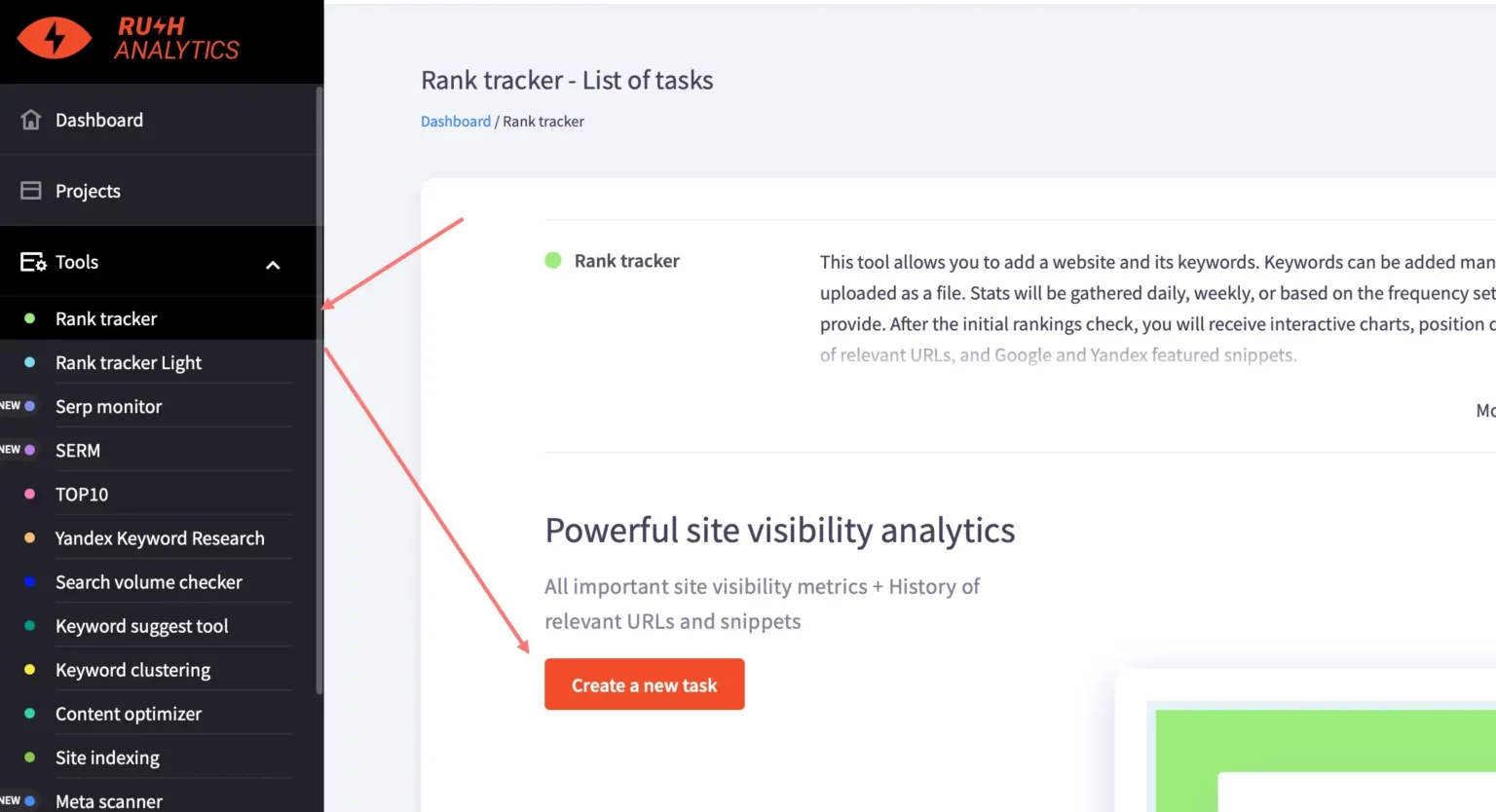
Here you need to enter the name of the task (mandatory field). You can enter any name; it is often convenient to enter the name of the site so that in the future it will be easy to find the right task.
Next, specify the URL of the site for which you are going to collect the positions; positions will be taken for the entire site. If you need to collect positions for one specific URL (for example, for a group in social networks or your page on YouTube) choose the “Exact URL” option under the expert options.
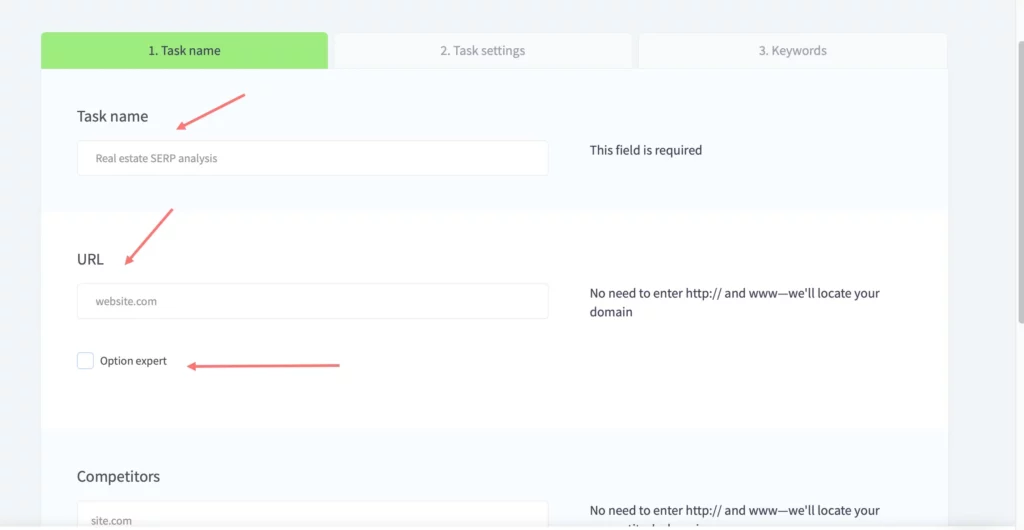
Step 2. Specify keyword rank tracker settings
Here you need to select the device for which you are going to check the positions, and the search engine which will be used to collect them. For Google, all regions and all languages are available, and unlimited number of regions can be added to the task.
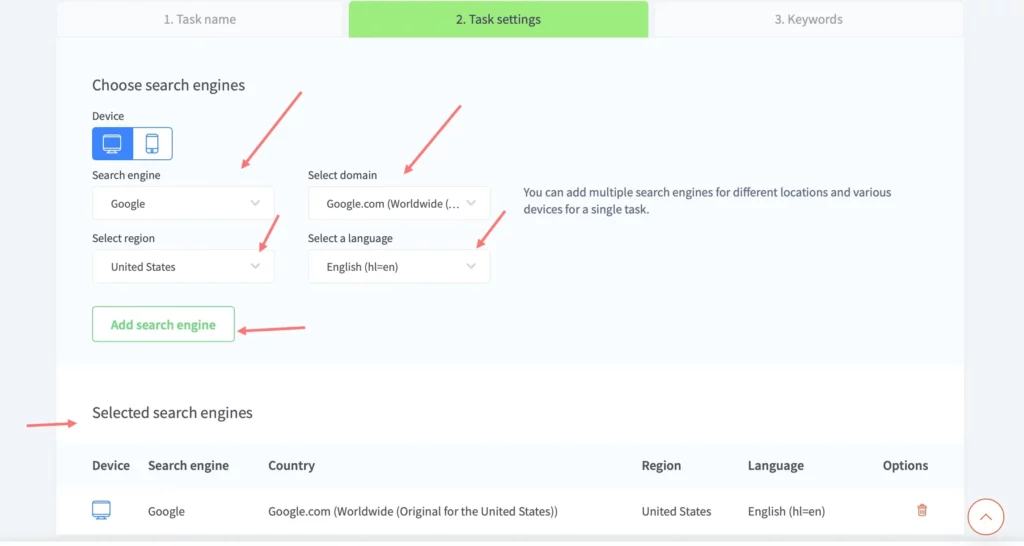
Step 3. Add keywords and groups
Here it is possible to upload keywords in the interface field as well as via a file.
Using a file, you can upload not only specific keywords but also groups and relevant URLs for them. You can download a sample file for uploading.
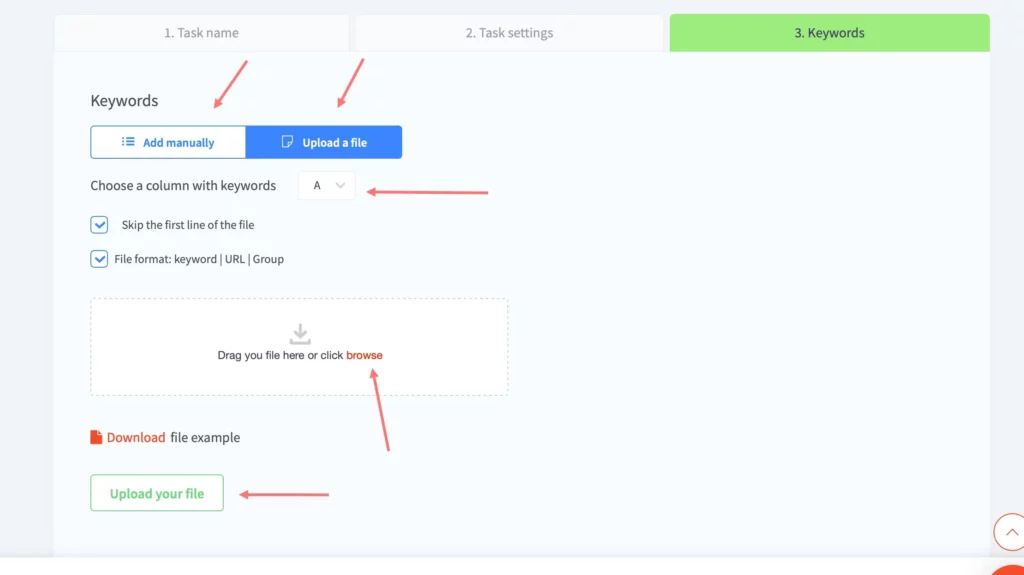
Step 4. Get the results
After a few minutes, you will be able to see results such as:
- position in Google SERP
- competitors’ ranking
- overview of the results according to the previous period
- and much more other metrics
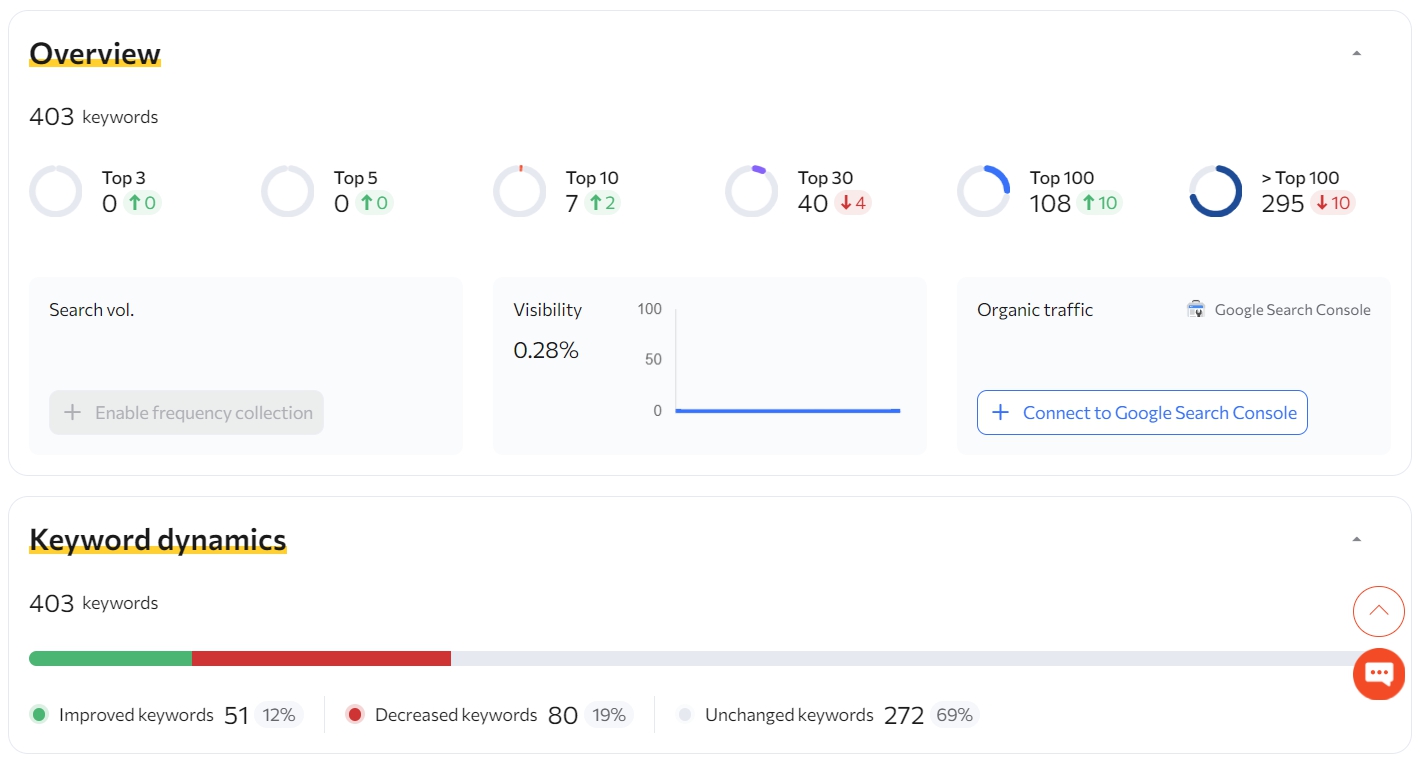
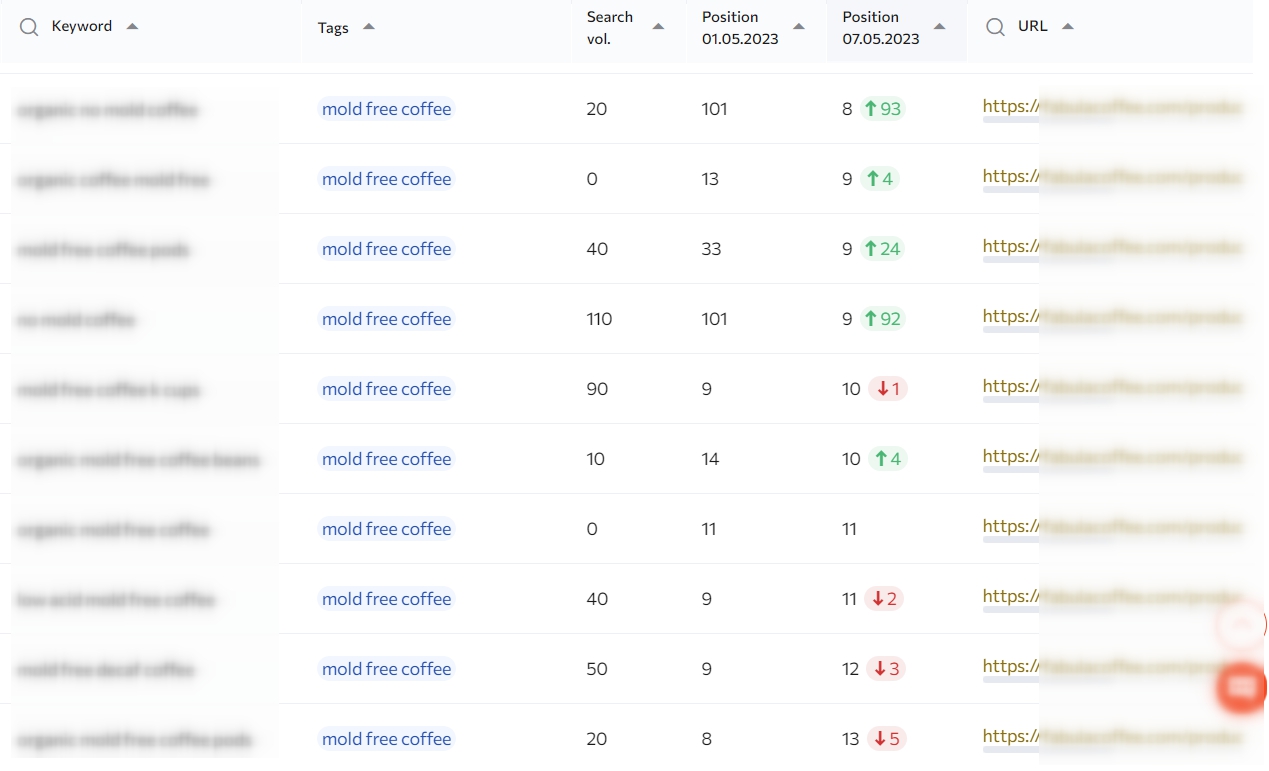

How much does it cost to assess a website’s position?
The cost depends on the list of functions provided. It is possible to choose the best pricing plan by taking into account the type of online resource and the requirements for the depth of analysis by positions.
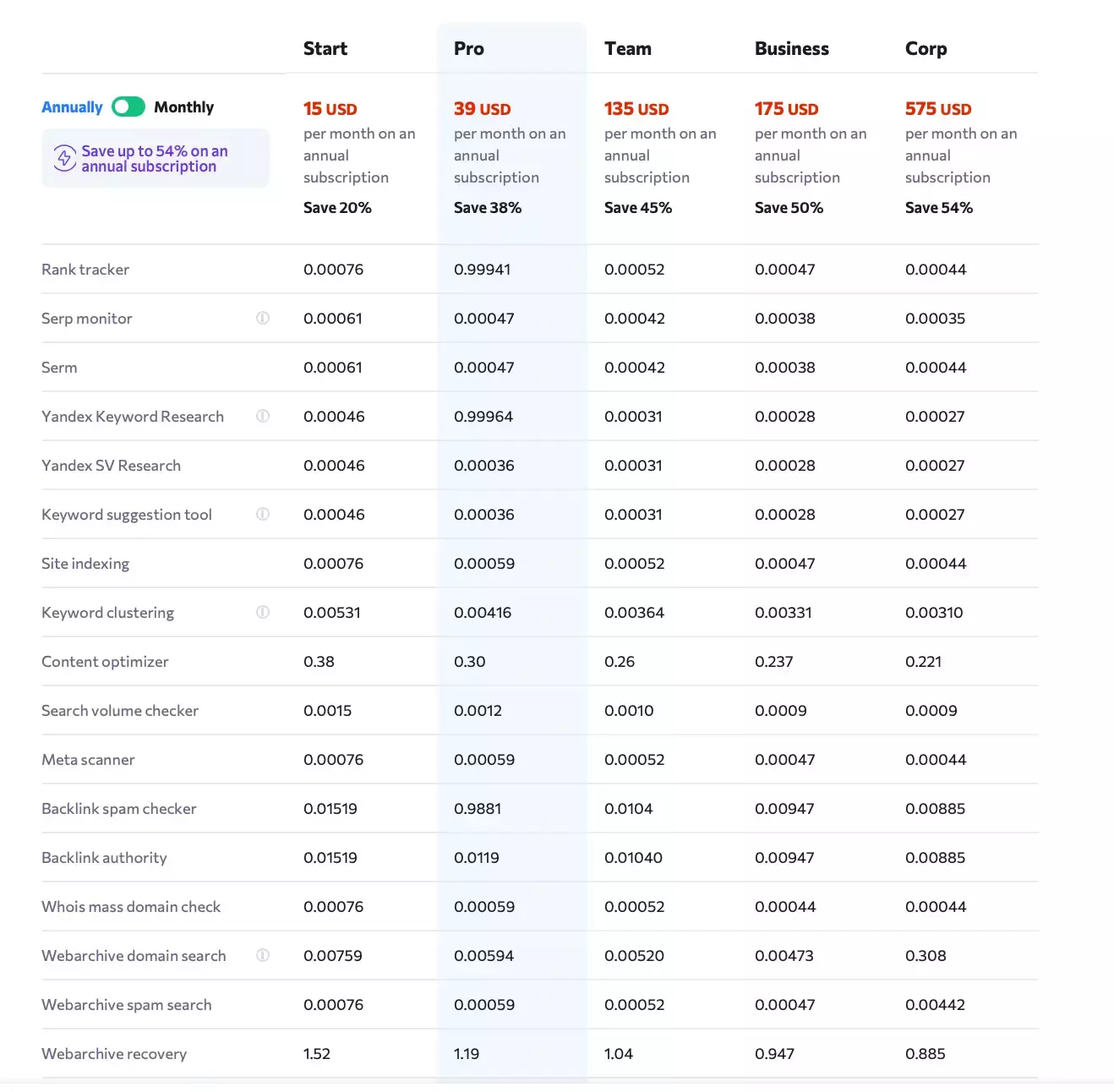
In Rush Analytics Rank tracker tool, the plans include services for compiling an optimal keywords and search suggestions, and then clustering them (arranging them according to certain parameters). There is also a check of page indexing, the spamminess of the links, and other indicators necessary to improve the website’s position.
Get 7 days free trial access to all tools.
No credit card needed!

Factors affecting a site’s position in a ranking list
When ranking an online resource, hundreds of different factors are taken into account. Content quality, link count, behavioral factors, adaptive design for mobile devices, and many more things influence search engine ranking results. The reason search engines use such complex algorithms is that there are numerous similar sites in highly competitive industries, they want to provide users with the highest quality and most useful search results.
What factors positively influence the position of your website?
- High-quality texts on all pages of the site optimized for high volume, middle volume and low volume queries. The content of the resource should not only consist of product descriptions; you should also publish product reviews, useful thematic articles, videos, etc.
- High-quality product images (more than one picture).
- A wide range of goods.
- Clearly shown product prices.
- Adaptive design for different types of devices (computers, mobile phones, tablets).
- Convenient services: payment through the website, online order form, online consultant, etc.
- Quick “Share” buttons with links to social media accounts and groups.
- Quality external links. Check the donor sites and domains that link to your resource. Donors should promote the same or similar subjects, and should not contain many outbound links. To increase the correlation (dependency) positions of the site, keywords or queries should be inserted in the link text.
- High volume and middle volume keywords in the meta tags, etc.
How to improve website positioning
A number of measures need to be taken regularly to improve a website’s position. Increasing positions allows a website to reach the top of organic search rankings, attract new customers and increase sales.
What you need to do to get your website up in the results:
- Create unique and useful content and optimize the texts that are already placed. Monitor competitors’ resources that are at the top, survey users: what exactly do they want to know about a product? Texts should answer your target audience’s questions, solve their problems. And be sure to update your texts regularly!
- Think about design and easy navigation. Usability (the user-friendliness of the resource) plays a huge role for visitors. Attractive, but not overly flashy design, clear search and checkout forms keep visitors on the site, increasing the conversion rate (percentage of desired actions).

- Gradually build up the number of quality links. Check donor sites. Buy permanent and temporary links on thematic resources with high attendance and similar themes. Set up logical internal linking on your domain.
- Connect analytics services. Google Analytics and Google Webmaster Tools not only give you detailed analyses of the effectiveness of your SEO, but also have an influence on the ranking.
A website’s position in a search engine is an indicator of the effectiveness of its SEO. You should strive to bring your website to the top 10 for popular keywords, as this is what determines the level of sales and profitability of your online business. To do that, you need to monitor its position, create unique content, improve its usability, and add new services to boost the user experience (UX).






